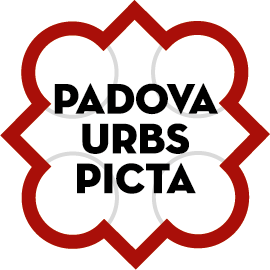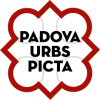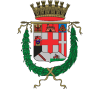Prato della Valle on Market Day
Our starting-point is Prato della Valle, which every Saturday is home to a large outdoor market where you can find just about everything: from clothing to plants and flowers. One Sunday a month there is also a very well-stocked Antiques Market, and over the course of the year this market area is home to various other initiatives: historically-inspired events, promotions of local produce and even sporting occasions. In 1808, Prato della Valle was used for the first trotting race in Italy. The event was called the Sedioli Race, after the name given to the single-seater two-wheeled carriages harnessed to the trotting horses; those vehicles made their initial appearance here in Padua, a ‘first’ which is reflected in the fact that they are now known as ‘Padovanelle’. The entire event is commemorated by a plaque you can see under the portico in Prato della Vallle itself, close to Via Umberto I. If you take this Via Umberto I out of the huge city square, you enter a pedestrian street (complete with a cycle path) which is lined by shops, cafés, old palazzi and other aristocratic residences. This long shopping street links the north and south of the old city centre – a sort of ‘Shopping Mall with a View’. The stock in the shops along this street ranges from luxury goods to craftwork, so there is something for every budget. And at the end of the street you come to Ponte delle Torricelle, under which flows the Naviglio Interno (Inner Canal). Passing over the bridge, you enter Via Roma, another pedestrian street lined with shops of all kinds and cafés full of exquisite delights. Padua is located in an area where the fashion industry has long been important. Shoemakers, furriers, jewellers and clothiers are traditional figures among the manufacturers of the Veneto, providing Padua with the highest-quality products – and nurturing the development of craft skills within the urban area as a whole. Padua has also long been renowned for its skill with food products – in particular, bread and pastries. As an old proverb puts it: “Bread from Padua, Wine from Vicenza, Tripe from Treviso and Women from Venice”.
The Old Ghetto and the City Piazzas.
Almost at the end of Via Roma, a small street on the left – Via Soncin – leads into the Old Ghetto, where there are specialist shops and bars serving the traditional spuncioni – small snacks to be eaten with an aperitif. The name comes from the fact that, for the convenience of customers, they are served at the end of toothpick-like sticks (spuncioni or spuciotti, from the dialect verb spunciare, meaning ‘to prick’).
Piazza delle Erbe
Via Soncin runs all the way through the Ghetto to Piazza del Duomo; here, if you resist the temptation to stop at one of the cafés or shops, you turn right into Piazza dei Signori. This is one of the three interconnected squares that are home to a daily market: in Piazza dei Signori itself, a market of clothes, accessories and small household items; in Piazza delle Erbe, fruit and vegetables; in Piazza della Frutta, a combination of the two. In fact, there are really four markets if we include the stalls on the ground floor beneath the Palazzo della Ragione, also known as Il Salone (which will be discussed separately). And all four have a rich history. Traditionally, from the Middle Ages onwards, market stalls were the only commercial activity women were allowed to engage in – even if the stall itself had to be in the name of a male member of the family. Thus, the markets in the Piazzas of Padua have always had a strong female presence. The stalls were often popularly known by the name of the women who ran them, and the calls of the market traders were female voices – directed at customers who themselves were predominantly female.
The Listón and the eastern districts of the old city centre
From the Piazzas to the Listón there is a distinct change in atmosphere: from lively market stalls one passes to the elegant shops of the pedestrian area that stretches from the Canton del Gallo (“Cockerel Corner”, the junction of Via San Francesco, Via San Canciano, Via Roma and Via VIII Febbraio) to Piazza Garibaldi, which stands on a site which in Roman times was occupied by the Baths and the Forum. A sole survivor of the grandiose colonnades that once occupied this spot, the Column of the ‘Madonna dei Noli’[Our Lady of the Carters] stands in the centre of the piazza. Crowned by a statue which gives it its name, the column itself is in Aurisina limestone from the Karst Plateau of the Trieste area and will have been brought here along one of the numerous waterways that once ran through the city. However, before you come to Piazza Garibaldi, you will, alongside Caffè Pedrocchi, pass by a small square called the Piazzetta della Garzeria; the name comes from the Garzeria or Garzerie Nuove where wool from the area’s fine sheep was worked (garzare means ‘to tease wool’). The plaque at the corner of Via Cesare Battista, engraved with the figure of a sheep, marks the boundary of what were the premises of the Università della Lana [Wool Guild], which was famous throughout Europe during the period of Carraresi rule; equipped with workshops and even a fontico [warehouse], the building survived until its demolition in 1926. In the same square, on a site now occupied by a supermarket, there once stood the very popular Teatro Garibaldi; a wood structure whose construction was promoted by Luigi Duse (grandfather of Eleonora Duse), this was where the famous dialect plays centring around the figure Giacometo Spàsemi were performed. Towards the middle of the twentieth century the theatre was first converted into a cinema and ultimately destroyed. At the end of the Listón, on the right, stands the Porta Altinate that opens into the district of the same name. Here, Via Eremitani, Via Zabarella, Via Altinate, plus all the other streets that link up with Via San Francesco and delimit the Antenore District, provide another opportunity for shopping.
The pedestrian area of the Listón then continues beyond Piazza Garibaldi to become Via San Fermo, which is lined with designer shops. It is very difficult to describe all that is on offer in these few streets, whether you are in search of luxury goods or gastronomic treats. Each street in the centre has at least one distinctive shop; and each neighbourhood has markets, craft shops and stores that are worth exploring.
Useful Information
This itinerary, which takes in shopping as well as the discovery of local food and wines – without ignoring the artistic/historical beauties of the city – centres around a stroll through the Restricted Traffic Area and pedestrian zones of the centre. The route described is purely indicative. In each district of the city there are opportunities to discover characteristic shops, local markets, pastry shops, gastronomies and wine bars that are full of the rich range of produce from this area. You would be well advised to make use of public transport (bus, tram, taxi) to reach the old city centre, or to park your car in the Piazza Rabin car park in Prato della Valle.












